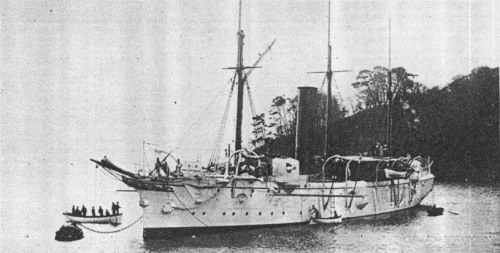

Archer 1888
| Name | No | Yard No | Builder | Laid down | Launched | Comp | Fate |
| Archer | 226 | Thomson, Clydebank | 2.3.1885 | 23.12.1885 | 7.1887 (commissioned 11.12.1888) | sold 4.1905 | |
| Mohawk | 227 | Thomson, Clydebank | 2.3.1885 | 6.2.1886 | 7.1887 (commissioned 16.12.1890) | sold 4.1905 | |
| Brisk | 228 | Thomson, Clydebank | 2.3.1885 | 8.4.1886 | 20.3.1888 | sold 5.1906 | |
| Porpoise | 229 | Thomson, Clydebank | 2.3.1885 | 7.5.1886 | 12.2.1888 | sold 2.1905 | |
| Cossack | 230 | Thomson, Clydebank | 2.3.1885 | 2.6.1886 | 7.1888 (commissioned 1.1.1889) | sold 4.1905 | |
| Tartar | 231 | Thomson, Clydebank | 2.3.1885 | 28.10.1886 | 7.1888 (commissioned 30.6.1891) | sold 4.1906 | |
| Serpent | Devonport DYd | 9.11.1885 | 10.3.1887 | 3.1888 | wrecked 10.11.1890 | ||
| Racoon | Devonport DYd | 1.2.1886 | 6.5.1887 | 7.1888 | sold 4.1905 |
|
Displacement normal, t |
1770 |
|
Displacement full, t |
1950 |
|
Length, m |
68.6 pp 73.2 oa |
|
Breadth, m |
11.0 |
|
Draught, m |
4.42 |
|
No of shafts |
2 |
|
Machinery |
sails + 2 2-cyl HC direct action, 4 boilers |
|
Power, h. p. |
natural draught: 2500 Archer, Mohawk, Brisk, Porpoise, Cossack, Tartar: forced draught: 3500 Serpent, Racoon: forced draught: 4500 |
|
Max speed, kts |
natural draught: 15 Archer, Mohawk, Brisk, Porpoise, Cossack, Tartar: forced draught: 16.5 Serpent, Racoon: forced draught: 17.5 |
|
Fuel, t |
coal 475 |
|
Endurance, nm(kts) |
7000(10) |
| Armour, mm | steel; deck: 10, gunshields: 25, TT: 25, CT: 76 |
|
Armament |
Archer, Mohawk, Brisk, Porpoise, Cossack, Tartar: 6 x 1 - 152/26 BL Mk VI, 8 x 1 - 47/40 3pdr Hotchkiss Mk I, 2 x 1 - 11.4/78, 1 - 356 TT (bow aw), 4 - 356 TC Serpent, Racoon: 6 x 1 - 152/26 QFC Mk I/VI / II/VI / III/VI, 8 x 1 - 47/40 3pdr Hotchkiss Mk I, 2 x 1 - 11.4/78, 1 - 356 TT (bow aw), 4 - 356 TC |
|
Complement |
176 |
Project history: These vessels were modified versions of Scout class with dimensions increased to accommodate a main armament of six 152mm guns. Four of these weapons were disposed as in the earlier class while the extra pair were mounted one each side on the upper deck amidships. The remaining weapons and the system of protection was arranged as in the Scout. Machinery power was increased but the wider beam and increased displacement resulted in a 0.5kt drop in design speed except in the two ships built in die Royal Dockyard, Serpent and Racoon, in which the engine power was raised to 4500ihp for a designed speed of 17.5kts. All exceeded their designed power on trials (which were ran light) and most exceeded 17kts while the Royal Dockyard pair exceeded 18kts. The machinery was arranged as in the Scout except that the two engines were filled in separate engine rooms, that forward driving the port shaft and that aft the starboard shaft. The machinery power was comparatively high for the size of ship and the engine and boiler rooms were very cramped but the plant proved reliable and most of the ships of the class enjoyed long careers. They were the last British cruisers to be fitted with horizontal engines. In appearance they differed from the Scout class in having three masts instead of two, and a clipper stem. They were reasonable sea boats but were overgunned for their size which caused them to roll abnormally at times and made them very wet in heavy weather. Like the Scout class they were too small and too slow to serve as effective torpedo vessels and were reclassified third class cruisers shortly after completion.
Ship protection: A 10mm steel deck, just below water level, provided splinter protection to the machinery compartments, and 25mm plating was fitted around the torpedo ports, but the main forms of protection were extensive watertight subdivision and the provision of wing coal bunkers abreast the boiler rooms and above the protective deck over the length of the machinery compartments.
Modernizations: None.
Naval service: Serpent wrecked near Corcubion Bay (Northern Spain) 10.11.1890.
Many thanks to Wolfgang Stöhr for additional information on this page.

Brisk as built
© Ivan Gogin, 2008-09